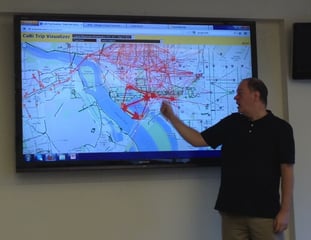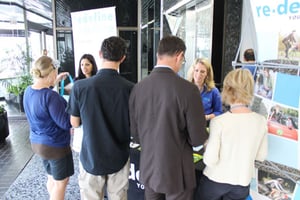Do you remember telephone operators? Have you ever heard of telephone operators, or switchboard operators? If the only thing that comes to mind are black and white photos of Victorian women seated in rows in front of large panels of cords, then you are correct. Telephone operators, once tasked with connecting phone lines before the days of automation, have gone the way of the dodo – quite extinct.
Some in the world of transportation demand management have recently wondered if TDM practitioners are becoming like telephone operators, as real-time transit information, smart phones, and mobile apps take over our lives and offer us instant access to what we need to know to get around. What room is there for TDM if individuals can access this information on their own? Will we be stranded at our switchboards while everyone else is cruising their iPhones?
Recently we had a presentation on some different types of real-time transit screens that display real-time transit information closest to the location of the screen. The Redmon Group is currently developing digital signs that will be piloted in residential properties and  office buildings. The digital signs will show nearby Metro trains and buses, Capital Bikeshare stations and bike availability, ART buses, and other related transit options. Other web-based programs have been built by individuals - Michael Schade’s projects are innovative and useful. His Side by Side Router is a great tool – plug in your start and end points, and a map will show you where to go on the bus, Metro, by bike, or by foot, and how long each will take. Check out his Capital Bikeshare Visualizer, too, showing an amalgamation of all the trips taken over a certain period of time. It’s fun to mentally compare where others in your own neighborhood travel to on those big red bikes.
office buildings. The digital signs will show nearby Metro trains and buses, Capital Bikeshare stations and bike availability, ART buses, and other related transit options. Other web-based programs have been built by individuals - Michael Schade’s projects are innovative and useful. His Side by Side Router is a great tool – plug in your start and end points, and a map will show you where to go on the bus, Metro, by bike, or by foot, and how long each will take. Check out his Capital Bikeshare Visualizer, too, showing an amalgamation of all the trips taken over a certain period of time. It’s fun to mentally compare where others in your own neighborhood travel to on those big red bikes.
But as fun as all the high tech wizardry is, this will not replace people. Basically, no matter how high tech the trip planners are, they still don’t help people overcome the barriers to getting out of the car and onto the bus, or Metro, or carpool, or bike. They do not show “how transit works,” – where to catch the bus, how to use a Metro card, how to indicate a stop, and more. What use will all this technology be, if no one knows how to utilize it? A recent article, “The Human Side of the Energy Equation,” touches on this as well: different studies reported that “technology alone isn’t enough”.
This is where TDM services like Arlington Transportation Partners comes in. The peer-to-peer services that ATP offers helps inform potential transit-riders about these technologies, in the same way we show how to find bike maps and bus schedules. And our personalized meetings help us talk through the barriers, and encourage individuals to think about the baby steps needed to actually change their behavior. In fact, as our world becomes increasingly digitized, it will become more important than ever to have a personal touch on whatever services TDM offers. Meeting face to face will be even more valued, rather than a generic email, mobile browser, or text message. So maybe it’s time to set up an appointment with your ATP rep, and move your relationship from a digital one to a personal one!
like Arlington Transportation Partners comes in. The peer-to-peer services that ATP offers helps inform potential transit-riders about these technologies, in the same way we show how to find bike maps and bus schedules. And our personalized meetings help us talk through the barriers, and encourage individuals to think about the baby steps needed to actually change their behavior. In fact, as our world becomes increasingly digitized, it will become more important than ever to have a personal touch on whatever services TDM offers. Meeting face to face will be even more valued, rather than a generic email, mobile browser, or text message. So maybe it’s time to set up an appointment with your ATP rep, and move your relationship from a digital one to a personal one!

